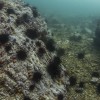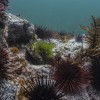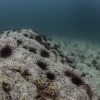My trek to Channel Islands National Park was a testament to the goodwill of strangers. I took the Yankee Freedom II ferry from Dry Tortugas National Park and University of Miami professor Keene Haywood generously gave me a ride to my hotel in Key West. I repacked all of my bags for the airport, and caught a few hours of sleep before heading to the Key West airport.
I arrived at the airport at 6 a.m. with my two carry-ons and three check-in bags in tow. The stunned
baggage handler took a look at my pile of luggage and hesitantly informed me that passengers were only allowed one check-in bag when flying out of Key West. Whoops! Luckily another airline employee had been camping at Fort Jefferson while I was there, so with a little southern charm and sweet-talking I was able to get all three checked bags on the plane with no extra charge.
Two flights and a bus ride later I arrived in Ventura Harbor, where I met up with Josh Sprague, a Marine Ecologist in the park. He and his housemates all work in the park, and they graciously let me crash at their place, catch up on my laundry and mooch their WiFi. One challenge of this internship is that there’s often no Internet or cell reception in the field, so it puts the onus on me to manage my time wisely and upload blog posts whenever I’m able. Easier said than done!
After a restful Sunday enjoying an afternoon picnic/barbecue, we made our way to Ventura Harbor to begin our 5-day fieldwork aboard the Sea Ranger. I’ve spent more time on a ship or a boat in the last few weeks than I have on land!
Our team includes David Kushner, the Regional Dive Officer and a Marine Biologist, Kelly Moore, the Park Dive Officer and a Park Ranger, our Captain, Keith Duran, Josh Sprague, a Marine Ecologist, and James Grunden, Jamie McClain, Ben Grime and Ryan Stephenson, who are all Biological Science Technicians.The monitoring program at Channel Islands is the longest ongoing monitoring program in the Park Service, and has been running for 32 years. Our goal for this trip is to perform several types of surveys on permanent sites to assess population growth of various organisms, including kelp, abalone, sea stars, and other ecologically important species.
It took 4-5 hours to get from Ventura Harbor to our first diving stop in Santa Rosa. During that time I was frantically studying the names of Pacific fish species in order to properly identify them for the survey dive. My Caribbean species identification skills are fair, but diving in the Pacific is a whole other ball game! With Kelly and Jaime’s help I was able to cram enough to do some basic identification during the dive.
After our first survey dive at the site, I popped back in with camera in hand to do a video survey. Shooting video expressly for science was new to me, and I enjoyed swimming up and down the 100m transect while collecting footage. The video clips will be used to count urchin populations along the transect line, and then to extrapolate the data to build larger population models.
The diving in Channel Islands was definitely different than the warm waters of Biscayne and Dry Tortugas. For each dive I double layered both a 3mm and 5mm wetsuit to stay warm. I felt a lot like the Michelin Man, but it worked! Each dive was usually at least one hour, and most were closer to an hour and a half long. All were rigorous, whether I was doing video transects, photographing or assisting with surveys. At one point we had to deal with significant surge, which would send us flying to and fro as we attempted to count kelp.
After diving at Santa Rosa we set out for San Miguel, which is the most remote of the Channel Islands. This meant that the sites were almost untouched, except for a few fishing boats. The island’s remote location also means that it is influenced by different currents, in this case colder water currents. Fortunately the boat was well-equipped to deal with the diving conditions. There was a hot water hose to warm your wetsuit before and after dives, of which I unashamedly took full advantage.
Diving in the relatively untouched conditions gave me an opportunity to see species I’d only seen in aquariums. Octopuses, sheepshead, garibaldi, sea lions: Every time I looked around I’d see something new! I even got to see a nudibranch for the first time, and had my first encounter with a harbor seal who played with my fins.

A nudibranch
Unfortunately, the lush kelp forests we saw in San Miguel weren’t the norm for our trip. Reserves make up only 20% of the Channel Islands, so areas that aren’t protected are open to commercial and recreational fishing. Several of our dive sites were in such unprotected areas, and we saw the effects of fishing firsthand. Many of these sites were “urchin-barren,” meaning that due to a lack of natural predators, urchins had dominated the ecosystem and created a monochromatic, barren landscape.
Seeing this radical difference in marine life between protected and non-protected areas was definitely a shock, and even a little depressing. However it definitely impressed upon me the need for the continuation of long-term monitoring programs, so that parks can better understand the different factors influencing marine ecosystems.
Another biological factor at play in the park was the emergence of a sea star wasting disease. This new disease has hit Sunflower sea stars extremely hard, wiping out most of the population in the park. Sunflower sea stars eat urchins, and the lack of this predatory sea star has left the urchin population to grow unchecked. The wasting disease also affects other types of sea stars, as we saw on our trip.
As the trip wound down to the last few days we finished up our research at Santa Cruz. After the day of diving was completed I did a quick three-mile hike on the island with Josh, Ben and Ryan. With so much diving it can be easy to overlook the natural beauty of terrestrial systems, so the hike was a great opportunity to explore the island. The hike, combined with the beautiful sunset, was a great way to reflect on all the things I’d seen thus far.
When I asked Brett and Dave what their favorite park was at the beginning of the summer, they both answered that each one had it’s own unique appeal and that it was impossible to pick a favorite. As I explore parks across the United States, I’m beginning to understand their answer. Each one has its own allure, some mysterious and fascinating pull. Hopefully I’ll be back to explore more of Channel Islands’ mysteries.
















Love your blog. You are a gifted story teller. Your images give readers a sense of place and connect them to your narrative. Keep up the good work. The special places you are helping protect need more people to know about them in the intimate way you provide.